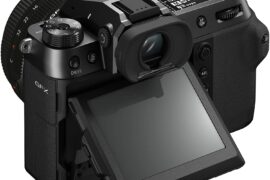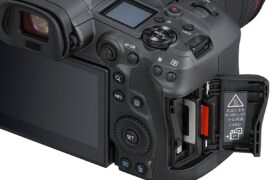Introducing the newest Hollywood star about to shock audiences everywhere: The DJI Zenmuse X5S camera aboard the Inspire 2 drone in a film called The Ascension of Ava Delaine. Oh, and also the lead actress, director, and producer of this single-take, all mobile device-shot film, complete with multiple wardrobe changes: Tonya Kay.
I had the pleasure of chatting with this seasoned performer and new director (Tonya, not the drone). As I imagine a lot of SolidSmack readers are, I was mostly unaware of how the cinema world works, but I was fascinated by Ms. Kay’s aggressive adoption of drone tech. Cinematographer and Drone Operator Andria Chamberlin was also kind enough to answer some of the more technical questions.

How It All Started
Tonya and her team decided to take on the AT&T Shape Create-A-Thon challenge in the Mobile Film category. This year, some of the mobile category rules they had to meet were: films had to be shot on smartphone, tablet or drone and it could be no more than 5 minutes long. Other constraints included having less than 4 weeks between “green light and delivery”. . . which my engineering mind takes to mean between “go time and deadline”.
Something her team DID NOT have to do (but did anyway): shoot that ~5 minutes of mobile device footage in a single take. So that means no stopping the camera while Tonya changed her wardrobe 4 times. Nudity was hidden from the camera’s view, but Tonya tells me her amazing crew braved, “way more of my nekkid (sic) body than they signed up for that day.” She also performed and changed costumes as she ran up multiple floors of a building! On each floor was a different scene representing a different decade of the character’s life.
Some Questions with Tonya Kay
ERIN: “How many were on your crew (besides the drone)?”
TONYA KAY: “19 altogether, including but not limited to writer/co-producer Shaula Evans, cinematographer/drone operator Andria Chamberlin, sound designer/foley artist Jamie Billings, co-executive producer Dennis Ho, post-production at Digital Jungle Post and of course crazy-eyed me doing lots of things you can read in the credits.”
ERIN: “Why drone? What cinematic advantages does filming with a drone bring? (Pretend like we know nothing about cinematography . . . because most of us don’t.)”
TONYA KAY: “I chose to make an all-drone narrative film because I’ve never seen it done and I’m an artistic daredevil. Screw easy, boring and safe – in my art, it’s okay if it hurts, so long as it’s real.
“Also, as my directorial debut, I was realistic about a 5-minute short not garnering much attention unless it was so risky, so renegade, so ridiculously bold that folk would watch just to see how we did it. Heck, high-level collaborators came on board for the exact same reason.
“Why have I never seen an all-drone, single-take narrative film? Because it’s difficult af! Had we had a substantially larger budget, we might have taken three days on location to rehearse and capture the five minutes of sunset you’ll see in the film, but that’s nearly all I would have changed. It was suggested that we could have used a ($300,000/day) crane to do this, but I disagree: a crane could not have traveled over the rooftop before taking a 180-degree rotation like we did. A drone was the only equipment that could have accomplished this camera movement and sometimes it takes limited resources to recognize that.”
The Super Technical Q’s With Andria Chamberlin
ERIN: “How was the drone controlled? Were locations and times programmed in before shooting or was it maneuvered in real time by remote control?”
ANDRIA CHAMBERLIN: “We had two drone operators for the Inspire 2 using the X5 camera. One controller managed the drone’s flight path and the other operated the camera’s gimbal. The shot started out handheld, so one operator held the drone while the other pulled focus and controlled the gimbal. The shot continued through the launch at which point the person doing the handheld operation switched to control the gimbal, while the other controlled the drone’s flight path. The drone’s flight path was pre-programmed prior to the shoot off-site on an app called AutoPilot using actual GPS coordinates of the location. We rehearsed the drone’s path in a field up by Paramount Ranch a few days prior to the actual shoot date. When we got to location, the alley and the location being in Downtown LA posed a problem accessing satellites – so although we had the whole operation pre-programmed, the drone couldn’t access enough satellites and we had to operate manually.”

ERIN: “What kind of control do you have on the camera settings during filming? Did you control those in real time or was it all automatic or was one focus and aperture setting and etc. OK for the whole film?”
ANDRIA CHAMBERLIN: “We had complete control of all camera settings throughout the 5-minute continuous shot. We had to rack focus throughout as the drone and the actor moved throughout the windows and each floor. We were shooting on a 25mm lens on the X5 which is a 2x crop factor, and at times all the way open at f2 as the sun started to go down, so pulling focus was essential. We even racked aperture at points to account for drastic changes in brightness of direct sun, shadow, interior windows, and eventually the rooftop.”

ERIN: “You mentioned the geolocation software not working the day of filming because one of the satellites was not in the line of sight. What were some other technical limitations you ran into?”
ANDRIA CHAMBERLIN: “We actually only had 5 satellites accessing the drone on the day of the shoot – we needed about 15 for the drone to work properly in our pre-programmed flight path. This was because we were in a tight alley surrounded by tall buildings in downtown.
“Other technical limitations probably would be the drone itself. The drone on a 25mm lens trying to hold a closeup mid-air is tough, especially when you add wind, an alley into the equation, and a 5-minute single-take altogether where everything needs to be spot on or the whole take doesn’t work. Drones are brilliant for wides and always look very steady, but as you start to film subjects closer and closer it becomes more challenging to hold a shot in place.
“We really wanted to the drone to start off handheld and then seamlessly launch from our hands – but the Inspire 2 has incredibly dangerous blades that could seriously injure someone. We would’ve needed to purchase specially made handles for the drone, and other protective gear for our bodies but we had limited time due to our deadlines and couldn’t get the handles in time. So what we did instead, was built a launch platform the same height as where the camera needed to be during the handheld portion, and pulled back to a wide where we set the camera seamlessly down on the platform. We launched from the platform without cutting. Some launches were smoother than others . . .
“We also were using the X5 camera which has its own picture limitations. The limited dynamic range of 9 stops on the camera made it tough to go from shadow to interior windows to direct sunlight all in one shot. As such, some highlights are more blown out than say an Alexa’s 14 stops would have.”

ERIN: “If you could wish a feature or gizmo into existence, what would make your job of filming with a drone easier? (This will be read by a bunch of hardware enginerds — maybe they can make it happen!)”
ANDRIA CHAMBERLIN: “For this particular shoot, a satellite mesh network or ground stations to fill in the gaps in the satellite network caused by the cityscapes would’ve allowed us to use our pre-programed flight path without problems. Better wireless protocols would’ve helped that as well. If the drone didn’t have those problems that day, we basically could’ve sat back and just pulled focus and aperture and let the drone fly the path we had programmed for it automatically.
“Hand launching made easier for the Inspire 2 would’ve helped this shot as well. If ever a shot needs to start handheld on a person’s feet, follow them in a close-up through some action, and then end up on a rooftop (as ours did), the ability to hand launch safely and with ease, would’ve been amazing!”
More Questions for Tonya:
ERIN: “Tell me more about those crazy costume changes! How many did you do? How much did your athleticism factor into you pulling that off? How did you hide it from the camera?”
TONYA KAY: “What you see from the drone front is the movie. What was happening behind those walls was a whirlwind of rambunctious nudity and focused determination. It’s a good thing I was a professional dancer for 26 years before I acted in this shoot, because we treated the staging of The Ascension of Ava Delaine more like choreography between the drone and lead actress. I literally changed clothes while running between floors of the building to meet our drone on a new floor in a new decade of time, in new wardrobe with a new set of emotions. “The drone, meanwhile, was navigating its own choreography on the outside of the building between our meetups, as well.

“I couldn’t have done it without the crew, braving way more of my nekkid body than they signed up for that day. I had one person on each floor assisting the wardrobe changes. I had another crew member on each floor on walkie communicating with the camera department things like, ‘Eyes on Tonya floor 2. She’s out of her head piece. Pulling up gown. Exiting onto balcony in 3 .. 2 . . .’ Then, get this — I’m the director, too, right? Then I’d hit my mark, yell ‘action’ for the camera to find me and my 1st AD (Assistant Director), SaraAnne Fahey, would yell another ‘action’ to me when she saw I was in frame. It was more like theatre with the energy of real-time everything.

“I decided early on to scrap all shoe changes for time, so you will only see me with footwear in the very first vignette. I under-dressed everything I could. So the lingerie, for example, in the 4th vignette, was worn under 3 vignettes prior. I wore hats or headpieces to account for the lack of hair style change-time. When I finally got to the rooftop, my chest was heaving so hard, I had to absolutely meditate myself clam in the two seconds it took for the camera to find me.
“As an actress, I’ve never done anything like this. I’ve seen continuous-shot films, but the actors weren’t doing real-time quick changes or ascending entire buildings through five decades in five min. It was insane and ridiculously fun.”
ERIN: “If you could explain to me in general more about how the filming worked, that would be great. I was a bit confused with you saying it was a 5-minute single-take but then you also had to do a segment shot on-location at the WB studios.”
TONYA KAY: “There’s the movie you pitch, then there’s the requests studios/network place on your movie. In this case, it was the AT&T SHAPE competition which made the request. This is just like the real-world film/tv-making process, by the way. A producer, writer, director, actress – every artist can expect their initial concept to change and change again every step of the way. If you want your work to be seen by more than your pets, you gotta be able to collaborate. I’ve always said: a true artist isn’t someone who has brilliant creative ideas, it’s someone who has those ideas, takes the notes, includes revisions, even makes mistakes and then still creates brilliance incorporating all the twists and turns. I find it absolutely thrilling.
“Yes, the competition requested (required) we use a shot from Warner Bros, which threw us for a loop when they also unleashed the news that Warner Bros wouldn’t be allowing drones. Our green lit pitch was for an all-drone, single-take film and my ego felt a battle! Instead of going berserk, I decided this was a lesson more about who I am going to be as a filmmaker and less about the project itself. As the director, am I going to cry about the integrity of my film or am I going to craft a way to stay true to the film’s original concept while showing AT&T and Warner Bros that I play well with others? I genuinely crave teamwork and incorporating this request actually challenged me to be even more creative with a solution AND taught me how to keep cool and treat people well even when under considerable artistic and deadline pressure. A successful filmmaker = solutions.
“You’ll see I chose to include a separate shot filmed at Warner Bros right at the top of the film for the production company’s title card. It actually sits in nicely, incorporates the competition’s request and is a creative way to honor the production company, Danger Arts.
“And if I want, I can remove the requested clip for future cuts. You know what I’m saying.”
More Items on the Technical Wish List
Tonya told me there were 2 other camera/drone features from a post-production view that would have made making this film easier.
One was not having compression automatically placed on the video files. While the film was shot in 5k, and while the format appeared to be RAW, Tonya tells me there was still noticeable compression applied. In editing, her team didn’t have full access to colorizing options. She says she’s not unhappy; they still were able to perform a lot of colorizing effects. This aspect was vital to the artistic storytelling of the project as the team colorized the different vignettes representing different decades to reflect the colors and tones we associate with those time periods. They would have liked to do even more, though!
The other thing on Tonya’s wish list was even more image stabilization. While the way these camera-drone combos are built is fantastic for far-away scenery views, it’s not as great for close-ups. I’m told that means any filming done 10 feet away or closer. Because this film was entirely shot in that close-up range, and also shot outside in the wind, adjustments made to the drone’s positioning are much more noticeable.
If you happen to be working on developing hardware for film production that pushes the technical envelope, and you’d like to have it tested out with this production company — Danger Arts, Tonya will be happy to chat with you. To get general feedback or even to get a sample film produced with your stuff, you can talk ideas with Tonya Kay through the contact page on her website.
When Can We See the Film?
The crew will be submitting The Ascension of Ava Delaine to every upcoming film festival they possibly can! Keep watch on SolidSmack for updates. Once those are over, the film will be available online to view. In the next few weeks, a trailer is expected to be available on the film’s website: The Ascension of Ava Delaine
Other Links to the Film and Crew:
The Ascension of Ava Delaine IMDb Page






